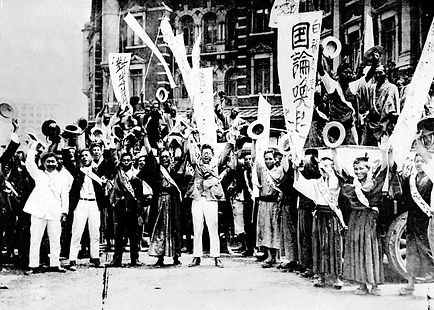TIMELINE: Arab Immigration to the United States
In the preface to the script, the playwright explains that "it's important to understand Arab immigration patterns to understand the world of the play" (3). Below is a timeline that details the history of Arab immigration to the United States.
1880-1924
Political and financial pressures caused many families to immigrate to the US. In the early 1900s, the Ottoman Empire declared that Christians would be conscripted into the military. Many Christian families chose to leave for this reason. Around the same time, the silk industry collapsed in Lebanon. Many silk farmers immigrated to other countries, hoping to find work (Little). Historians estimate that over 80% of early Arab immigrants were Christian. The minority were Jews and Muslims (Khater and Stevens).
Turkish Immigrants on Ellis Island Circa 1907 (Gado)
The Immigration Act of 1924
In 1924, Congress passed The Johnson-Reed Act. This law drastically decreased the number of immigrants allowed each year. It mostly affected immigrants from Asia and the Middle East because the limit was only a 2% increase from each current demographic in the US (Diamond).
Protest of the 1924 Act in Tokyo (NY Daily News Archive)
Immigration and Naturalization Act of 1965
“It’s kind of an amazing confluence of events. Right before President Kennedy died, he introduced a bill to abolish these ethnic origins quotas. The bill doesn't really go anywhere, just as every other effort hadn't gone anywhere in 40 years. As usual, there's just not a lot of interest in changing the immigration quotas.
But when he is killed, President Johnson looks at the unfinished business of Kennedy and [thinks], ‘Let's honor the memory of our late president. Let's really do right by his memory. Let's make this stuff work. We've got to pass it.’” (Diamond).
LBJ signing the 1965 Act on Liberty Island (Corbis)
1965-present
2017 "Muslim Ban" Rally in NYC (Platt)
Immigration from Arab countries continued to rise through the 1990s. After the attacks on 9/11, the United States started to instigate policies that made Arab immigrants feel less welcome. One of these policies was that Muslim men over the age of 16 who immigrated from certain countries were required to be photographed and fingerprinted annually.
Arab immigration slowed again in 2017 after President Donald Trump signed an executive order which restricted travel, immigration, and refugee status from six predominantly Muslim countries. President Joe Biden revoked the ban in 2021 (Little).
Conclusion
Learning more about Arab immigration patterns helps the reader have a better understanding of Leila's family. The playwright explains: "Leila and her family are not new to America. They would have been desperate to assimilate and would have been quite good at it" (3). Since Leila's family is Christain and Lebanese, it is probable that Leila's great-grandparents were born in the United States. She likely has no family in the Middle East, and she probably knows very little about Islam. This understanding of Arab immigration history also intensifies the racist comments of Leila's peers.
Bibliography
Diamond, Anna. “The 1924 Law That Slammed the Door on Immigrants and the Politicians Who Pushed It Back Open.” Smithsonian Magazine, 19 May 2020, https://www.smithsonianmag.com/history/1924-law-slammed-door-immigrants-and-politicians-who-pushed-it-back-open-180974910/.
Khater, Akram, and Marjorie Stevens. “‘Like a Wolf Who Fell upon Sheep’: Early Lebanese Immigrants and Religion in America.” Khayrallah Center for Lebanese Diaspora Studies News, NC State University, 6 Feb. 2019, https://lebanesestudies.news.chass.ncsu.edu/2019/02/06/like-a-wolf-who-fell-upon-sheep-early-lebanese-immigrants-and-religion-in-america/.
Little, Becky. “Arab Immigration to the United States: Timeline.” History.com, A&E Television Networks, 23 Mar. 2022, https://www.history.com/news/arab-american-immigration-timeline.



